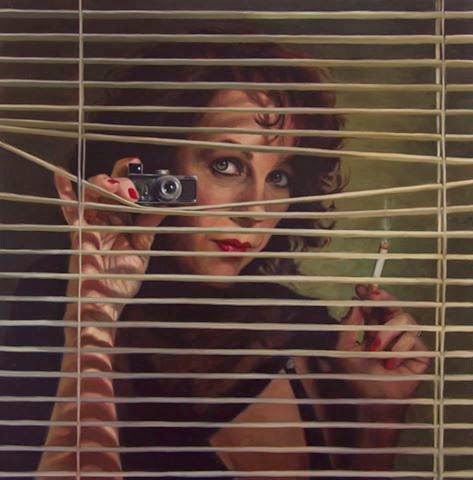The second in a series exploring the female self-portrait in contemporary realism.
“The good thing about painting a self portrait is that the model always shows up. Bad thing is, sometimes the artist doesn’t.”
Unknown
Posing for yourself
Sometimes an artist paints herself as a model, or actor in her own painting. Unlike the classic self-portrait, these paintings are often about something other than who the artist “is” as an artist…and sometimes explore issues the artist has a very personal connection to. They are self-portraits…with a twist.The reason you use yourself as model and muse often begins with the convenience factor (see the quote above.) When your model knows the exact expression and feel you’re trying to achieve in your work, she’s an invaluable muse whose presence and creativity is vital to the painting. And if you’re lucky, and your face and body possess the qualities your painting needs, it’s truly a win-win.
And yet, even these types of paintings still elicit the same old tiresome comments about beauty and narcissism.
 |
| chaos theory 4 by Diane Feissel |
 |
| chaos theory 7 by Diane Feissel |
 |
| chaos theory 11 by Diane Feissel |
 |
| Can’t see me like this! by Sharon Pomales |
 |
| XXL Volume and Curl by Sharon Pomales |
Why do people assume that painting yourself is an act of vanity? Sharon Pomales explores the theme of vanity in a series by that name. Not meant as self-portraits per se, but she was the most agreeable model to pose with foils in her hair and while putting on eyeliner.
 |
| Girl in Blue by Teresa Oaxaca |
Teresa Oaxaca paints and draws herself often. Her art, her life, her look…her “brand” is a decadent baroque feast. She dresses and lives in the world that her paintings show. Of these paintings of herself, she says, “I make so many I will say that I don’t really think of them as self-portraits. Rather I am using myself as a model to convert expressions or ideas.”
| Girl in Pink by Teresa Oaxaca |
 |
| Suburban pastoral by Haley Hasler |
Haley Hasler, who depicts incredibly complex fantasies of motherhood in crisply painted, seemingly light-hearted yet also serious detail, exclusively uses herself as the central mother character. Balancing cakes, babies, mice, violins and ponies, posing as topiaries, brunches and hamster pagaents, she embodies the sophisticated tongue-in-cheek bliss of motherhood and perfectly plays the role her paintings demand. The depth, richness and lines of her own face in these works play an integral role in showing the dazzling, magical, hard-working complexity of motherhood.
And yet, viewers have asked why she doesn’t Botox her face in these paintings…you might as well tell John Singer Sargent to clean up his room and make his bed before he’s allowed to paint it.
 |
| The Artist in his Studio by John Singer Sargent |
“The self portrait has become important to me because I am not interested in portraying ‘Girl, Interrupted’ or, the woman being watched. Rather, it is the woman…the self, the interior…doing the Looking. Humor is a provocative tool.”
 |
| Portrait as a Sunday Brunch by Haley Hasler |
“We have been trained that looking at a woman must be confined to what is typically ‘Male Looking’; from the outside, loaded with desire and appraisal of the surface exterior on display. What does an artist do when she is inside that body, and looking at the outside of it from within?
The beauty of art and painting is that the medium is meant to go beyond surface appearance, beyond cliché, beyond what we think we know. In representing ourselves we are literally “Re-Presenting.” Provocative and frightening, yes. Be prepared for incomprehension, and the occasional animosity that comes when we challenge the status quo, challenge the obligation to prettify, smooth out and display [ourselves] as a commodity for appraisal.”
Haley has a response to the usual compliments viewers will give a female artist…that her portrait doesn’t do her justice, that she’s so much prettier.
“Pardon me, but why do you think that the way you perceive me has any bearing on my own art-making act? Why do you freely insist that you know better?”
Admittedly she hasn’t actually said this to anyone yet, but I’d love to be there when she does!
Sidestepping the beauty issue with humor
 |
| Poof by Jennifer Balkan |
JenniferBalkan uses her own image for her painting concepts, which have a light-hearted
airy feel to them. She says that, “Because my pieces often
have some absurd element to them, people usually just laugh when they see them.
My recent ones though have taken on a wee more serious note.....so we’ll see
what the reaction is.”
 |
| Wilted by Jennifer Balkan |
Sidestepping the beauty issue with cancer
 |
| Self Portrait by Karen Yee |
 |
| What Lies In Wait by Karen Yee |
Karen painted What Lies In Wait, after a conversation with her doctor about a particular medication that caused strange side effects. “He was reluctant to take me off the medicine, saying he was afraid the cancer would become active again. I told him I knew the cancer was at the door, and I didn’t want to open it and let it in even a little bit. Thus the painting.”
 |
| Fight Like A Girl by Karen Yee |
In upcoming blogs we’ll explore the smile, relationships, turbulence, defiance, doppelgangers and nudes in the female artist self-portrait.
by Judy Takács
Cecilia Beaux Forum
Chair New Media Relations
Portrait Society of America
Cecilia Beaux Forum
Chair New Media Relations
Portrait Society of America


















